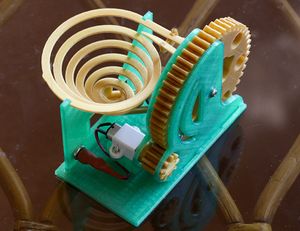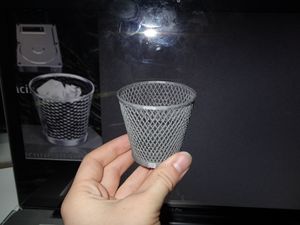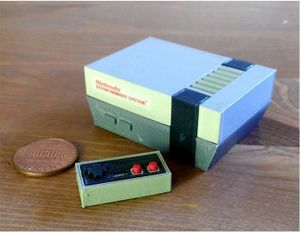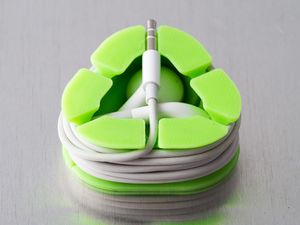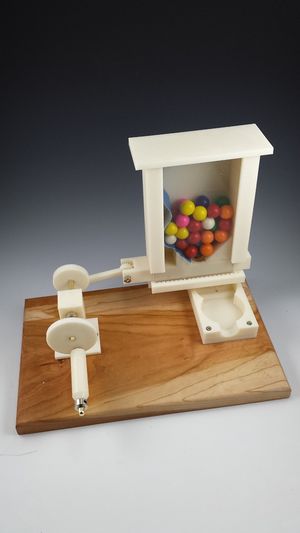User:Npm5073/Blog
Main | About Me | Class Blog
For this class we write weekly blogs on a variety of topics that have to do with 3D printing.
Contents
Blog 1: Thingiverse
We had to explore around on Thingiverse and find different items.
An item that is amazing/beautiful
Here is a marble machine that is powered by a small electric motor. I find this marble machine pretty amazing because of its creativity. I don't think it does anything particularly useful, but it is a good example of a fun projected that can be created with a 3D printer. Source
An item that is funny or strange
Seeing a printed version of the Mac OSX trash bin made me laugh. This is one of many designs I found that have little practical uses, but are incredibly intricate. I suppose it would make an interesting paper weight though. This was also a top contender for the next category: An item that is useless. Source
An item that is useless
Here is a miniature Nintendo (notice the size of it compared to the penny). No matter how cool a super tiny Nintendo looks I can't think of it could be used for. I also find it interesting that it is made out of 8 different parts. Again I'm impressed by the complexity of things that seem useless to me. Source
An item that is useful
Here is an earbud case designed for easy storage of earbuds. This is one of many items that I wanted to print immediately after I saw it. This earbud case makes me excited about additive manufacturing because it gives people the opportunity to create products to meet their needs. Source
An item that surprised me
I never would have thought about making a gum machine out of printed parts. This is something that gets me thinking about how many industries 3D printing will impact in the future. It also makes me want some bubble gum. Source
Blog 2: Open Source Blueprints for Civilation
A) The Open Source Ecology project was created to design and build the machines that will benefit society by sharing and building off of their respective ideas. I like the idea of the OSE project because their designs are meant to be inexpensive to build compared to buying a new, similar machine. During his TED talk, Marcin talks about the financial difficulties he experienced as a small scale farmer. I live on a small farm in Lancaster, PA owned first by my grandfather and now my uncle. I have seen the financial struggles firsthand. The newest and greatest equipment is too expensive for these small farmers to afford, so they need to buy used equipment. My uncle uses two tractors that were made in the mid 1950's and they constantly need to be repaired.
The start-up costs alone were enough to discourage me from a farming career at a young age. But the OSE project gives me hope that small farms will once again become profitable. I love that you can build the tools that you need and make changes to them when necessary. In this video, Marcin talks about building tools that can replicate themselves (he even gives a shout-out to REP RAP). He mentions that he wants to design a set of machines that are necessary to start a civilization. I do not think that we need to reinvent the wheel with all of Marcin's ideas, but I do see his point with regard to products that are designed to break after a certain time or overpriced equipment. I am excited to see where this project goes in the next few years. I hope that more and more people contribute to the project so machine design will continue to improve. Hopefully someday soon it won't be uncommon to see someone plowing a field with a tractor they built.
For more information on OSE see: TED Talk Open Source Ecology Wiki
B) The New Yorker magazine recently wrote an article about the OSE project called THE CIVILIZATION KIT. They talked a lot about Marcin's philosophy about OSE and the living conditions at his farm. He is very set on the idea of living in a civilization that is self-sufficient. I think this article is a little tough on Marcin. He is trying to build machines using as many simple processes as he can while working in the early stages of a brand new civilization. I'm not sure that he necessarily needs to work in those conditions though. I believe that the OSE project would be more efficient if they used modern techniques to make the initial machines. As long as the drawings and prototypes are made, OSE has accomplished their goal.
The New Yorker article also points out the poor living conditions mentioned by some of the volunteers at the OSE farm. I cannot imagine why not having running water or electricity would further OSE's mission of creating open source machines that are needed to create a civilization, but I respect that Marcin is using a majority of the money donated to the OSE project to build machines and further OSE's mission. I also do not find it surprising that OSE has some critical flaws. They are a nonprofit organization that is trying to build everything itself. So I would expect their facilities to be outdated and the working conditions to be less than ideal. It also makes sense that many of their volunteers were unqualified and left after a short time because of the living conditions and hard work required. I think that Marcin has some good ideas that will benefit society, but the execution of these ideas will be delayed because of the work environment the OSE team is subjected to.
Marcin wrote a short response to the New Yorker (found here). He clarifies OSE's goals to be solving pressing world issues, where the New Yorker article claimed that it was to start self-sufficient communities. He also claims that they are "not letting idealism prevent us from achieving our goals." I call BS on that one. If you do not have electricity in your facilities because you want to make it yourself, then I would say that you are letting idealism prevent you from achieving your goals. In the rest of the response, Marcin discusses how it is hard to run a nonprofit organization and why there are always going to be trade offs between comfort and progress. I agree with most of this defense because I would not want to be in his shoes and I do not think I would know a way to make OSE more efficient (other than more modern facilities). Overall, I think Marcin will struggle for the duration of the project to find qualified people who are as dedicated to the project as he is. If he can do that, I would be interested to see how it works out. But there is no way you will ever see me working for him (not that he would even want my help).
C) One professor I think would be interested in a PSU OSE club would be Leland Engel. When I took his ME 340 class, he was very focused on creativity and a design process that was very iterative. He is also an advisor for the FSAE car and a few other similar projects at Penn State. I am not sure what his opinion is on open source technology, but I think the engineering that would go on would entice him enough to hear us out.
Blog 3: 3D Printed Prosthetics
Who created this design and when/where was it done?
Mason Wilde used a 3D printer to print a prosthetic hand for a family friend. The designs Wilde used were created by Ivan Own and Richard Van As. The two designed the hand because Van As lost a finger in a wood working accident. The two made their first prototype in November of 2012 and had a 3D printer version by January of 2013.
How would one make one of these prosthetic hands? This design using a 3D printer can be found, free of charge, at www.thingiverse.com. The 3D printer might be harder to find, but any local college with an engineering department is probably a good place to start looking for one. There are also some tools needed to assemble the parts and the cost of the printing material.
For more information about this project or other similar ones see the following links.
Other News articles about this story 1 2 3
Other News article talking about this Design
4
5
6
7
8
9
10
11
Other 3D printed Prosthetic Hands:
12
13
Background story of the Robohand
Blog 4: A continued discussion on Blog 2 based on others input
Many of my classmates had good thoughts on the OSE project that I overlooked in my second blog post. Many of them had similar ideas about the challenges of these machines being made by everyday individuals or especially people in third world countries. Jess makes a good point when she says "I think that when it comes to building machinery, the average person would not consider them to be DIY, easy to fabricate projects. Even as a fairly intelligent person, myself, that is about to graduate with a degree in Mechanical Engineering, a project like this would likely take me a long time with the help of several people." Kevin goes one step further by talking about the issues that can come up when something breaks or isn't working properly. He said not having troubleshooting tips could cripple the development of the machines. Dongao seems to agree with this statement and has a good thought about the safety of building your own tractor. I know I would not want to drive a tractor that I built just due to the safety concerns. Zach also points at that these plans will be hard to spread to places in the world without access to computers and the internet.
Even with all the skeptics our there some people were willing to look past the issues with the project and see its benefits. Tom sees Marcin's true idea for the project is "not to provide instructions for the best machines that can possibly be made, but rather to provide complete instructions for pretty good machines". Anthony agrees with me about the benefits of having cheaper equipment when he said "In today’s world so much emphasis in product design is put into aesthetics even though it doesn’t affect the performance of the machine. Having a more affordable machine that gets the job done without all the bells and whistles can be just as beneficial to society". Eric finds himself wishing he lived in a simpler time without competing economic goals ruling the day. I too thing that a simpler life would be more enjoyable and I think we share that idea with Marcin, but I doubt either of us would go as far as Marcin to live that dream.
In all the blogs I read, Nam was the only person who ever mentioned that he would consider building any of these machine. If Marcin's project is going to be successful, educated people like Nam need to build Marcin's designs and add to them.
One thing that stuck out to me in the responses to the New Yorker article about OSE was that most people thought the Emily Eakin was unfairly critical of the project. One interesting thing I saw in Sam's blog is when he said that "She is unable to write an article for the common man because she isn't connected in any way with what I look at as the common man; Her husband is a professor at the Prestigious Brown University, she writes for the New Yorker. Come on". I agree that she probably has a different understanding of what the "common man" looks like than I do (being born and raised in Amish country and all). I think Ben is still speechless about this subject because of the deep sadness he feels when reading Eakin's critiques on OSE.
Blog 5: RepRap timeline
Look through the RepRap Media timeline page (accessible from our SCRUG main page) and attempt to identify the most significant events from the last few years. If you think there's something missing from the timeline, add it and claim it for XP - but include a summary! What projects continue to recieve coverage/press over time? What projects seem to have slowed or stopped?
Make sure you pick and point out at least one entry which you find: 1) An event very important in the progression of 3D printing technology (open source or not) 2) A not so important event in the progression of this technology (something overhyped perhaps?) 3) Something which you found interesting which you would like to think or speak more about. This might overlap with #1 a bit, depending.
57 102 117 124 142 148 153 154: Micro 3-D printer used to rapidly create tiny, complicated structures in seconds 159: The emergence of "4D printing" 191: Amaze project aims to take 3D printing 'into metal age 223: Harvard Wins Award fir 3D Printed Battery 235: Scientists develop new app to turn mobile phones into 3D scanners
